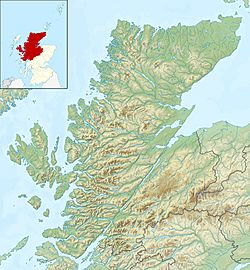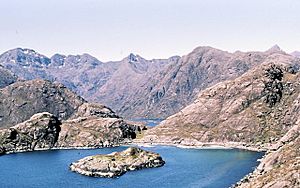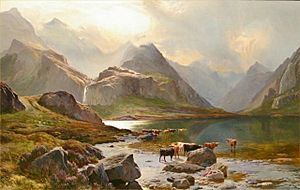Loch Coruisk facts for kids
Quick facts for kids Loch Coruisk |
|
|---|---|
 |
|
| Location | Isle of Skye, Highlands, Scotland |
| Coordinates | 57°12′27″N 6°10′08″W / 57.2074°N 6.1690°W |
| Type | freshwater loch |
| Primary inflows | Coruisk River, Allt a' Choire Riabhaich |
| Primary outflows | Scavaig River |
| Basin countries | United Kingdom |
Loch Coruisk is a beautiful freshwater loch (which is the Scottish word for a lake) located in the Scottish Highlands. You can find it on the Isle of Skye, right at the base of the amazing Black Cuillin mountains.
Its name comes from the Scottish Gaelic words Coire Uisg, meaning "Cauldron of Waters." This name really fits, as the loch is surrounded by dramatic mountains! Legend says that Loch Coruisk is home to a kelpie. A kelpie is a mythical water horse that can change its shape, sometimes even looking like a human.
Contents
Exploring Loch Coruisk
How to Get There
You can reach Loch Coruisk in a few ways. One popular option is to take a boat from a village called Elgol. This boat trip offers fantastic views of the coastline.
Another way is to walk! You can hike from Sligachan, which is about 7 to 8 miles (11 to 13 kilometers) away. If you're feeling adventurous, you can also walk from Elgol.
The Bad Step Challenge
The path from Elgol includes a tricky part known as "the Bad Step." This section can be a bit challenging, especially if you're not used to hiking or if you're a bit nervous about heights. It involves a short climb over some rocks.
What the Loch Looks Like
The northern end of Loch Coruisk is surrounded by the tall, dark peaks of the Black Cuillin mountains. These mountains are often covered in clouds, giving the area a mysterious feel.
At the southern end, a short river called the Scavaig River flows out of the loch. This river is only a few hundred yards long and empties into a sea loch, Loch Scavaig. Loch Coruisk itself is almost 2 miles (3.2 kilometers) long but only about 400 yards (365 meters) wide.
Loch Coruisk in Stories and Art
This dramatic loch has inspired many writers and artists over the years.
Famous Writers and the Loch
Sir Walter Scott, a famous Scottish writer, visited Loch Coruisk in 1814. He described it as a very wild and stern place:
- “Rarely human eye has known
- A scene so stern as that dread lake,
- With its dark ledge of barren stone…”
Another well-known poet, Lord Tennyson, also tried to see the loch. However, he had a tougher time:
- “Loch Coruisk, said to be the wildest scene in the Highlands, I failed in seeing. After a fatiguing expedition over the roughest ground on a wet day we arrived at the banks of the loch, and made acquaintance with the extremest tiptoes of the hills, all else being thick wool-white fog.”
The author Mark Haddon used the remote location of Loch Coruisk in his children's novel Gridzbi Spudvetch!, which was later re-released as Boom!. In the story, the loch serves as a secret portal! The book even describes the walk from Elgol, including "the Bad Step."
Robert Macfarlane wrote about his visit to the loch and its valley in his 2007 travel book The Wild Places. A description of the area makes up an entire chapter of his book.
Loch Coruisk in Paintings
Many artists have been inspired to paint Loch Coruisk's stunning scenery. Some of these artists include William Daniell (1769–1837), J. M. W. Turner (1775–1851), Sidney Richard Percy (1821–1886), and Alexander Francis Lydon (1836–1917). Their paintings help show how beautiful and wild this place truly is.




